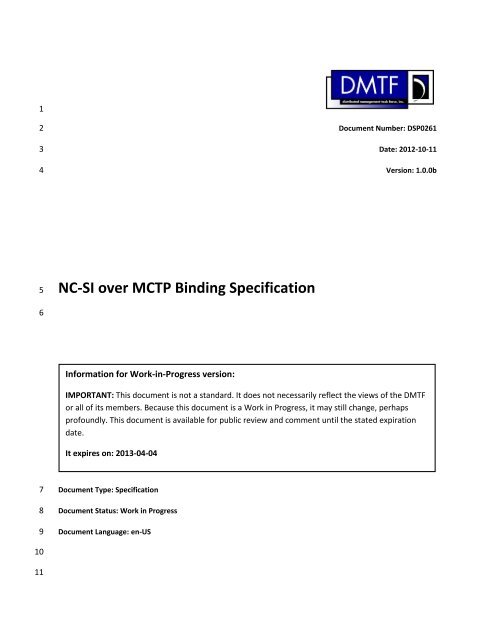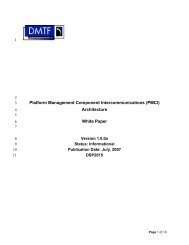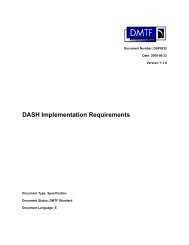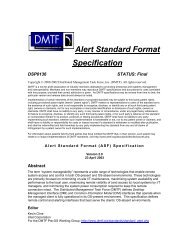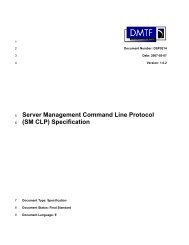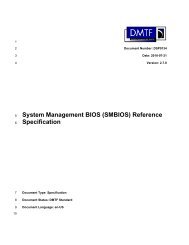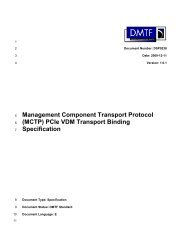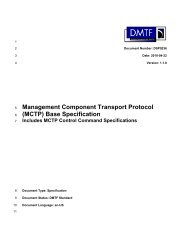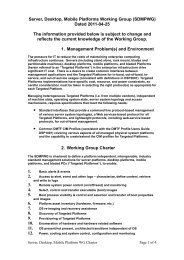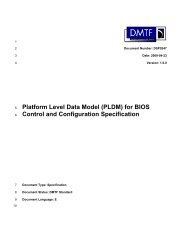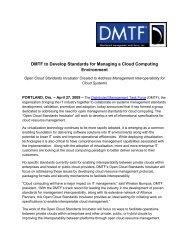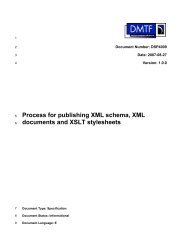DSP0261 - DMTF
DSP0261 - DMTF
DSP0261 - DMTF
You also want an ePaper? Increase the reach of your titles
YUMPU automatically turns print PDFs into web optimized ePapers that Google loves.
1<br />
2<br />
3<br />
4<br />
Document Number: <strong>DSP0261</strong><br />
Date: 2012-10-11<br />
Version: 1.0.0b<br />
5<br />
NC-SI over MCTP Binding Specification<br />
6<br />
Information for Work-in-Progress version:<br />
IMPORTANT: This document is not a standard. It does not necessarily reflect the views of the <strong>DMTF</strong><br />
or all of its members. Because this document is a Work in Progress, it may still change, perhaps<br />
profoundly. This document is available for public review and comment until the stated expiration<br />
date.<br />
It expires on: 2013-04-04<br />
7<br />
8<br />
9<br />
Provide any comments through the <strong>DMTF</strong> Feedback Portal:<br />
http://www.dmtf.org/standards/feedback<br />
Document Type: Specification<br />
Document Status: Work in Progress<br />
Document Language: en-US<br />
10<br />
11
NC-SI over MCTP Binding Specification<br />
<strong>DSP0261</strong><br />
12<br />
13<br />
Copyright notice<br />
Copyright © 2012 Distributed Management Task Force, Inc. (<strong>DMTF</strong>). All rights reserved.<br />
14<br />
15<br />
16<br />
17<br />
18<br />
19<br />
20<br />
21<br />
22<br />
23<br />
24<br />
25<br />
26<br />
27<br />
28<br />
29<br />
30<br />
31<br />
32<br />
33<br />
34<br />
35<br />
36<br />
<strong>DMTF</strong> is a not-for-profit association of industry members dedicated to promoting enterprise and<br />
systems management and interoperability. Members and non-members may reproduce <strong>DMTF</strong><br />
specifications and documents for uses consistent with this purpose, provided that correct attribution is<br />
given. As <strong>DMTF</strong> specifications may be revised from time to time, the particular version and release date<br />
should always be noted.<br />
Implementation of certain elements of this standard or proposed standard may be subject to third party<br />
patent rights, including provisional patent rights (herein "patent rights"). <strong>DMTF</strong> makes no<br />
representations to users of the standard as to the existence of such rights, and is not responsible to<br />
recognize, disclose, or identify any or all such third party patent right, owners or claimants, nor for any<br />
incomplete or inaccurate identification or disclosure of such rights, owners or claimants. <strong>DMTF</strong> shall<br />
have no liability to any party, in any manner or circumstance, under any legal theory whatsoever, for<br />
failure to recognize, disclose, or identify any such third party patent rights, or for such party’s reliance<br />
on the standard or incorporation thereof in its product, protocols or testing procedures. <strong>DMTF</strong> shall<br />
have no liability to any party implementing such standard, whether such implementation is foreseeable<br />
or not, nor to any patent owner or claimant, and shall have no liability or responsibility for costs or<br />
losses incurred if a standard is withdrawn or modified after publication, and shall be indemnified and<br />
held harmless by any party implementing the standard from any and all claims of infringement by a<br />
patent owner for such implementations.<br />
PCI-SIG, PCIe, and the PCI HOT PLUG design mark are registered trademarks or service marks of PCI-SIG.<br />
All other marks and brands are the property of their respective owners.<br />
For information about patents held by third-parties which have notified the <strong>DMTF</strong> that, in their opinion,<br />
such patent may relate to or impact implementations of <strong>DMTF</strong> standards, visit<br />
http://www.dmtf.org/about/policies/disclosures.php.<br />
37<br />
2 Work in Progress Specification - not a <strong>DMTF</strong> Standard Version 1.0.0b
<strong>DSP0261</strong><br />
NC-SI over MCTP Binding Specification<br />
38<br />
39<br />
40<br />
41<br />
42<br />
43<br />
44<br />
45<br />
46<br />
47<br />
48<br />
49<br />
50<br />
51<br />
52<br />
53<br />
54<br />
55<br />
56<br />
57<br />
58<br />
59<br />
60<br />
61<br />
62<br />
63<br />
64<br />
65<br />
66<br />
67<br />
68<br />
CONTENTS<br />
Foreword ....................................................................................................................................................... 5<br />
Introduction.................................................................................................................................................... 6<br />
1 Scope .................................................................................................................................................... 7<br />
2 Normative references ............................................................................................................................ 7<br />
3 Terms and definitions ............................................................................................................................ 8<br />
4 Symbols and abbreviated terms ............................................................................................................ 9<br />
5 Conventions .......................................................................................................................................... 9<br />
5.1 Reserved and unassigned values ............................................................................................... 9<br />
5.2 Byte ordering ............................................................................................................................... 9<br />
6 NC-SI over MCTP overview ................................................................................................................ 10<br />
6.1 NC-SI over RMII ........................................................................................................................ 10<br />
6.2 NC-SI over MCTP ..................................................................................................................... 11<br />
7 NC-SI over MCTP specific considerations .......................................................................................... 13<br />
7.1 Packages and channels ............................................................................................................ 13<br />
7.2 Routing of NC-SI Pass-through traffic ...................................................................................... 14<br />
7.3 Multiple NC support .................................................................................................................. 14<br />
7.4 Flow control ............................................................................................................................... 15<br />
7.5 Interleaving of messages .......................................................................................................... 15<br />
7.6 Ordering rules ........................................................................................................................... 16<br />
7.7 Assembly requirements ............................................................................................................ 17<br />
7.8 Multiple MCTP transport bindings ............................................................................................. 17<br />
7.9 Package selection ..................................................................................................................... 22<br />
8 Supported NC-SI commands .............................................................................................................. 23<br />
9 Message types .................................................................................................................................... 25<br />
9.1 NC-SI message type (0x02) ..................................................................................................... 25<br />
9.2 Ethernet message type (0x03).................................................................................................. 27<br />
10 NC-SI support specific to MCTP transport .......................................................................................... 29<br />
ANNEX A (informative) Notation and conventions ..................................................................................... 32<br />
ANNEX B (informative) Change log ........................................................................................................... 33<br />
69<br />
70<br />
71<br />
72<br />
73<br />
74<br />
Figures<br />
Figure 1 – NC-SI over RMII traffic flow diagram .................................................................................. 10<br />
Figure 2 – NC-SI over MCTP traffic flow diagram ............................................................................... 11<br />
Figure 3: Single MCTP EID to multiple NC-SI channels mapping .................................................... 13<br />
Figure 4: Multiple MCTP EIDs to multiple NC-SI channels mapping ............................................... 14<br />
Figure 5: Multiple MCTP transport bindings example......................................................................... 17<br />
75<br />
Version 1.0.0b Work in Progress Specification - not a <strong>DMTF</strong> Standard 3
NC-SI over MCTP Binding Specification<br />
<strong>DSP0261</strong><br />
76<br />
77<br />
78<br />
79<br />
80<br />
81<br />
82<br />
83<br />
84<br />
85<br />
86<br />
87<br />
88<br />
Tables<br />
Table 1 –MCTP Message types for NC-SI over MCTP ...................................................................... 12<br />
Table 2 – Supported NC-SI commands ................................................................................................ 23<br />
Table 3 –NC-SI messages encapsulation ............................................................................................ 26<br />
Table 4 - MCTP Transport Header fields.............................................................................................. 26<br />
Table 5 – MCTP Specific Message Header field ................................................................................ 26<br />
Table 6 – Ethernet messages encapsulation ....................................................................................... 28<br />
Table 7 - MCTP Transport Header fields.............................................................................................. 28<br />
Table 8 – MCTP Specific Message Header field ................................................................................ 28<br />
Table 9 – Get Supported Media Command Packet Format .............................................................. 29<br />
Table 10 – Get Supported Media Response Packet Format............................................................. 30<br />
Table 11 – Get Supported Media Response media descriptors format ........................................... 30<br />
Table 12 – Medium Change AEN Format ............................................................................................ 31<br />
4 Work in Progress Specification - not a <strong>DMTF</strong> Standard Version 1.0.0b
<strong>DSP0261</strong><br />
NC-SI over MCTP Binding Specification<br />
89<br />
90<br />
91<br />
92<br />
93<br />
94<br />
95<br />
96<br />
97<br />
98<br />
Foreword<br />
The NC-SI over MCTP Binding Specification Specification (<strong>DSP0261</strong>) was prepared by the Platform<br />
Management Components Intercommunications (PMCI Working Group) of the <strong>DMTF</strong>.<br />
<strong>DMTF</strong> is a not-for-profit association of industry members dedicated to promoting enterprise and systems<br />
management and interoperability.<br />
Acknowledgments<br />
The <strong>DMTF</strong> acknowledges the following individuals for their contributions to this document:<br />
Editor:<br />
Eliel Louzoun – Intel Corporation<br />
Contributors:<br />
99<br />
100<br />
101<br />
102<br />
103<br />
104<br />
105<br />
106<br />
107<br />
108<br />
<br />
<br />
<br />
<br />
<br />
<br />
<br />
<br />
<br />
Alan Berenbaum – SMSC<br />
Philip Chidester – Dell<br />
Benzi Friedman – Intel Corporation<br />
Ed Klodnicki – IBM<br />
Patrick Kutch – Intel Corporation<br />
John Leung – Intel Corporation<br />
Hemal Shah – Broadcom Corporation<br />
Tom Slaight – Intel Corporation<br />
Bob Stevens - Dell<br />
Version 1.0.0b Work in Progress Specification - not a <strong>DMTF</strong> Standard 5
NC-SI over MCTP Binding Specification<br />
<strong>DSP0261</strong><br />
109<br />
110<br />
111<br />
112<br />
113<br />
114<br />
115<br />
Introduction<br />
The NC-SI over MCTP Binding Specification defines new MCTP messages used to convey NC-SI Control<br />
packets and Ethernet traffic over MCTP to allow NC-SI Pass-through traffic over MCTP. This specification<br />
is based on the DSP0222 1.1 specification and uses the same NC-SI Control packet definitions.<br />
Document conventions<br />
Typographical conventions<br />
The following typographical conventions are used in this document:<br />
116<br />
117<br />
118<br />
119<br />
120<br />
<br />
<br />
<br />
<br />
Document titles are marked in italics.<br />
Important terms that are used for the first time are marked in italics.<br />
Terms include a link to the term definition in the "Terms and definitions" clause, enabling easy<br />
navigation to the term definition.<br />
ABNF rules are in monospaced font.<br />
121<br />
122<br />
123<br />
ABNF usage conventions<br />
Format definitions in this document are specified using ABNF (see RFC5234), with the following<br />
deviations:<br />
124<br />
125<br />
126<br />
<br />
Literal strings are to be interpreted as case-sensitive Unicode characters, as opposed to the<br />
definition in RFC5234 that interprets literal strings as case-insensitive US-ASCII characters.<br />
6 Work in Progress Specification - not a <strong>DMTF</strong> Standard Version 1.0.0b
<strong>DSP0261</strong><br />
NC-SI over MCTP Binding Specification<br />
127<br />
NC-SI over MCTP Binding Specification<br />
128<br />
129<br />
130<br />
131<br />
132<br />
133<br />
1 Scope<br />
The NC-SI over MCTP Binding Specification Specification defines the bindings between NC-SI protocol<br />
elements and MCTP elements in order for NC-SI Control and Pass-Through traffic to be transported<br />
using MCTP.<br />
Portions of this specification rely on information and definitions from other specifications, which are<br />
identified in clause 2. Two of these references are particularly relevant:<br />
134<br />
135<br />
136<br />
137<br />
138<br />
139<br />
<br />
<br />
<strong>DMTF</strong> DSP0222, Network Controller Sideband Interface (NC-SI) Specification, provides the<br />
NC-SI base control that is to be bound over MCTP by this specification. This specification will<br />
be referenced as NC-SI over RMII in this specification to differentiate it from NC-SI over MCTP.<br />
<strong>DMTF</strong> DSP0236, Management Component Transport Protocol (MCTP) Base Specification,<br />
defines the MCTP transport on which the NC-SI Control and Pass-through packets are to be<br />
conveyed.<br />
140<br />
141<br />
142<br />
143<br />
144<br />
145<br />
146<br />
147<br />
2 Normative references<br />
The following referenced documents are indispensable for the application of this document. For dated or<br />
versioned references, only the edition cited (including any corrigenda or <strong>DMTF</strong> update versions) applies.<br />
For references without a date or version, the latest published edition of the referenced document<br />
(including any corrigenda or <strong>DMTF</strong> update versions) applies.<br />
Unless otherwise specified, for <strong>DMTF</strong> documents this means any document version that has minor or<br />
update version numbers that are later than those for the referenced document. The major version<br />
numbers must match the major version number given for the referenced document.<br />
148<br />
149<br />
150<br />
151<br />
152<br />
153<br />
154<br />
155<br />
156<br />
157<br />
158<br />
159<br />
160<br />
<strong>DMTF</strong> DSP0222, Network Controller Sideband Interface (NC-SI) Specification 1.1<br />
http://www.dmtf.org/standards/published_documents/DSP0222_1.1.pdf<br />
<strong>DMTF</strong> DSP0236, Management Component Transport Protocol (MCTP) Base Specification 1.2<br />
http://www.dmtf.org/standards/published_documents/DSP0236_1.2.pdf<br />
<strong>DMTF</strong> DSP0237, Management Component Transport Protocol (MCTP) SMBus/I2C Transport Binding<br />
Specification 1.0<br />
http://www.dmtf.org/standards/published_documents/DSP0237_1.0.pdf<br />
<strong>DMTF</strong> DSP0238, Management Component Transport Protocol (MCTP) PCIe VDM Transport Binding<br />
Specification 1.0<br />
http://www.dmtf.org/standards/published_documents/DSP0238_1.0.pdf<br />
<strong>DMTF</strong> DSP0239, Management Component Transport Protocol (MCTP) IDs andCodes 1.2<br />
http://www.dmtf.org/standards/published_documents/DSP0239_1.2.pdf<br />
Version 1.0.0b Work in Progress Specification - not a <strong>DMTF</strong> Standard 7
NC-SI over MCTP Binding Specification<br />
<strong>DSP0261</strong><br />
161<br />
162<br />
163<br />
164<br />
165<br />
166<br />
167<br />
168<br />
169<br />
170<br />
171<br />
172<br />
173<br />
174<br />
175<br />
176<br />
177<br />
178<br />
179<br />
180<br />
181<br />
182<br />
183<br />
184<br />
185<br />
186<br />
187<br />
188<br />
189<br />
190<br />
191<br />
192<br />
ACPI, Advanced Configuration and Power Interface Specification Revision 4.0a, April 5, 2010<br />
http://www.acpi.info/DOWNLOADS/ACPIspec40a.pdf<br />
IETF, RFC4122, A Universally Unique Identifier (UUID) URN Namespace, July 2005<br />
http://www.ietf.org/rfc/rfc4122.txt<br />
IETF RFC5234, ABNF: Augmented BNF for Syntax Specifications, January 2008,<br />
http://tools.ietf.org/html/rfc5234<br />
ISO/IEC Directives, Part 2, Rules for the structure and drafting of International Standards,<br />
http://isotc.iso.org/livelink/livelink.exe?func=ll&objId=4230456&objAction=browse&sort=subtype<br />
3 Terms and definitions<br />
In this document, some terms have a specific meaning beyond the normal English meaning. Those terms<br />
are defined in this clause.<br />
The terms "shall" ("required"), "shall not," "should" ("recommended"), "should not" ("not<br />
recommended"), "may," "need not" ("not required"), "can" and "cannot" in this document are to be<br />
interpreted as described in ISO/IEC Directives, Part 2 ectives, Part 2, Annex H. The terms in parenthesis<br />
are alternatives for the preceding term, for use in exceptional cases when the preceding term cannot be<br />
used for linguistic reasons. Note that ISO/IEC Directives, Part 2, Annex H specifies additional<br />
alternatives. Occurrences of such additional alternatives shall be interpreted in their normal English<br />
meaning.<br />
The terms "clause," "subclause," "paragraph," and "annex" in this document are to be interpreted as<br />
described in ISO/IEC Directives, Part 2, Clause 5.<br />
The terms "normative" and "informative" in this document are to be interpreted as described in ISO/IEC<br />
Directives, Part 2, Clause 3. In this document, clauses, subclauses, or annexes labeled "(informative)" do<br />
not contain normative content. Notes and examples are always informative elements.<br />
Refer to DSP0236 for terms and definitions that are used across the MCTP specifications.<br />
Refer to DSP0222 for terms and definitions that are used in the NC-SI specification.<br />
The terms defined in DSP0004, DSP0223, and DSP1001 apply to this document. The following<br />
additional terms are used in this document.<br />
3.1<br />
System Power States<br />
S0 and Sx<br />
S0 represents an active system<br />
Sx represents system power states S1 – S5 which reflects various levels of inactivity of a system.<br />
8 Work in Progress Specification - not a <strong>DMTF</strong> Standard Version 1.0.0b
<strong>DSP0261</strong><br />
NC-SI over MCTP Binding Specification<br />
193<br />
194<br />
195<br />
196<br />
197<br />
198<br />
199<br />
200<br />
201<br />
202<br />
203<br />
204<br />
205<br />
206<br />
207<br />
208<br />
209<br />
210<br />
211<br />
212<br />
213<br />
214<br />
215<br />
216<br />
217<br />
218<br />
219<br />
220<br />
221<br />
222<br />
223<br />
224<br />
225<br />
226<br />
227<br />
228<br />
229<br />
The definition of the power states is as defined in ACPI.<br />
4 Symbols and abbreviated terms<br />
The abbreviations defined in DSP0004, DSP0223, and DSP1001 apply to this document. The following<br />
additional abbreviations are used in this document.<br />
4.1<br />
ACPI<br />
Advanced Configuration and Power Interface<br />
4.2<br />
IANA<br />
Internet Assigned Numbers Authority<br />
4.3<br />
FCS<br />
Frame Check Sequence<br />
4.4<br />
MCTP<br />
Management Component Transport Protocol<br />
4.5<br />
MC<br />
Management Controller<br />
4.6<br />
NC<br />
Network Controller<br />
4.7<br />
NC-SI<br />
Network Controller Sideband Interface<br />
4.8<br />
RID<br />
PCIe Requester ID (Bus/Device/Function).<br />
5 Conventions<br />
5.1 Reserved and unassigned values<br />
Unless otherwise specified, any reserved, unspecified, or unassigned values in enumerations or other<br />
numeric ranges are reserved for future definition by the <strong>DMTF</strong>.<br />
Unless otherwise specified, numeric or bit fields that are designated as reserved shall be written as 0<br />
(zero) and ignored when read.<br />
5.2 Byte ordering<br />
Unless otherwise specified, byte ordering of multibyte numeric fields or bit fields is "Big Endian" (that is,<br />
the lower byte offset holds the most significant byte, and higher offsets hold lesser significant bytes).<br />
Version 1.0.0b Work in Progress Specification - not a <strong>DMTF</strong> Standard 9
NC-SI over MCTP Binding Specification<br />
<strong>DSP0261</strong><br />
230<br />
231<br />
232<br />
233<br />
234<br />
235<br />
236<br />
237<br />
238<br />
239<br />
240<br />
241<br />
242<br />
243<br />
244<br />
245<br />
246<br />
6 NC-SI over MCTP overview<br />
NC-SI over MCTP is based on NC-SI over RMII (NC-SI). The NC-SI over MCTP Binding Specification<br />
replaces the RMII based Transport Protocol with a definition of NC-SI communications using MCTP. The<br />
MCTP Transport Bindings are defined in other companion specifications such as MCTP SMBus Binding<br />
Specification (DSP0237) and MCTP PCIe Binding Specification (DSP0238). Only the NC-SI command<br />
processing is inherited from NC-SI over RMII. Thus only parts of the NC-SI specification not related to<br />
the physical transport protocol may be relevant to this specification.<br />
6.1 NC-SI over RMII<br />
A Network Controller Sideband Interface (NC-SI) is a combination of logical and physical paths that<br />
interconnect the Management Controller and Network Controller(s) for the purpose of transferring<br />
management communication traffic among them. NC-SI includes commands and associated responses<br />
which the Management Controller uses to control the status and operation of the Network Controller(s).<br />
NC-SI also includes a mechanism for transporting management traffic and asynchronous notifications.<br />
Figure 1 depicts the NC-SI Traffic Flow Diagram as currently defined by NC-SI. As indicated, the interface<br />
is based on RMII. The figure depicts a single management controller and a single Ethernet device, which<br />
contains a single port. NC-SI comprehends multiple Network Controller devices (or “packages”) and<br />
ports (or “channels”).<br />
247<br />
Host Interface<br />
(e.g., PCIe)<br />
Remote Management<br />
Console<br />
Tx Pass-through Packets<br />
Network<br />
PHY<br />
MAC<br />
RX TX<br />
NC-SI Control<br />
Processing<br />
NC-SI Control<br />
NC-SI Response<br />
Packets<br />
RX RX Pass-through<br />
Packets<br />
RX Packet Filtering<br />
Packets<br />
RX<br />
TX<br />
NC-SI MAC (e.g. 100M)<br />
NC-SI Commands +<br />
TX Pass-through Packets<br />
NC-SI Ethernet<br />
Interface<br />
(Enhanced RMII)<br />
NC-SI Responses +<br />
Notifications +<br />
RX Pass-through Packets<br />
NC-SI MAC (e.g. 100M)<br />
RX TX<br />
(e.g., BMC)<br />
248<br />
249<br />
250<br />
Network Controller<br />
Figure 1 – NC-SI over RMII traffic flow diagram<br />
Management<br />
Controller<br />
10 Work in Progress Specification - not a <strong>DMTF</strong> Standard Version 1.0.0b
<strong>DSP0261</strong><br />
NC-SI over MCTP Binding Specification<br />
251<br />
The NC-SI specification can be divided in three parts:<br />
252<br />
253<br />
254<br />
255<br />
256<br />
257<br />
<br />
<br />
<br />
A physical layer based on enhancements to the RMII specification.<br />
A transport layer based on Ethernet packets. This layer allows differentiation of control frames<br />
based on a specific Ethertype (0x88F8).<br />
A control plane defining a set of commands used to configure and monitor the Network<br />
Controller and set the Pass-through channel for MC to network communication. This set can be<br />
extended using OEM commands.<br />
258<br />
259<br />
260<br />
261<br />
262<br />
263<br />
264<br />
265<br />
6.2 NC-SI over MCTP<br />
NC-SI over MCTP replaces the transport layer defined in NC-SI with MCTP. The physical layer used is one<br />
of the transport bindings on which MCTP can be bound (for example PCIe or SMBus).<br />
Figure 2 shows a possible architecture that provides equivalent functionality to [NC-SI] over MCTP. The<br />
NC-SI MAC block in each device is replaced by an MCTP block and a Medium-specific block. The MCTP<br />
block handles MCTP messages. The Medium-specific blocks consist of whatever layers are involved in<br />
mapping MCTP to an underlying medium such as SMBus, PCIe, or USB. Because the layering for each<br />
medium may be unique in its constitution and terminology, a generic single block is depicted.<br />
266<br />
Host Interface<br />
(e.g., PCIe)<br />
Remote Management<br />
Console<br />
Network<br />
PHY<br />
MAC<br />
RX TX<br />
Tx Pass-through Packets<br />
NC-SI and MCTP<br />
Control Processing<br />
NC-SI and MCTP<br />
Control<br />
NC-SI and MCTP<br />
Control Packets<br />
RX RX Pass-through<br />
Packets<br />
RX Packet Filtering<br />
Packets<br />
RX<br />
TX<br />
MCTP Physical Medium<br />
MCTP Control +<br />
NC-SI Commands +<br />
TX Pass-through Packets<br />
NC-SI over<br />
MCTP<br />
MCTP Control +<br />
NC-SI Responses +<br />
Notifications +<br />
RX Pass-through Packets<br />
MCTP Physical Medium<br />
RX TX<br />
(e.g., BMC)<br />
267<br />
268<br />
269<br />
Network Controller<br />
Figure 2 – NC-SI over MCTP traffic flow diagram<br />
Management<br />
Controller<br />
Version 1.0.0b Work in Progress Specification - not a <strong>DMTF</strong> Standard 11
NC-SI over MCTP Binding Specification<br />
<strong>DSP0261</strong><br />
270<br />
271<br />
272<br />
The differentiation between NC-SI Control and Pass-through packets is achieved by using two different<br />
MCTP message types as defined in DSP0239 and listed in Table 1.<br />
Table 1 –MCTP Message types for NC-SI over MCTP<br />
Message Type<br />
Message Type<br />
Code<br />
Description<br />
NC-SI Control 0x02 Messages used to encapsulate NC-SI Control traffic<br />
(commands, responses, and AEN) over MCTP<br />
Ethernet 0x03 Messages used to encapsulate Ethernet traffic (for<br />
example, NC-SI Pass-through) over MCTP<br />
273<br />
274<br />
275<br />
276<br />
Both NC-SI Control and Ethernet types of MCTP messages can be conveyed over multiple MCTP packets.<br />
The encapsulation of NC-SI Control traffic in MCTP messages is described in subclause 9.1.1. The<br />
encapsulation of NC-SI Pass-through traffic in MCTP messages is described in subclause 9.2.1.<br />
12 Work in Progress Specification - not a <strong>DMTF</strong> Standard Version 1.0.0b
<strong>DSP0261</strong><br />
NC-SI over MCTP Binding Specification<br />
277<br />
278<br />
279<br />
280<br />
281<br />
282<br />
283<br />
284<br />
285<br />
286<br />
287<br />
288<br />
289<br />
290<br />
7 NC-SI over MCTP specific considerations<br />
7.1 Packages and channels<br />
The NC-SI specification defines different topologies using the concepts of channels and packages. A<br />
channel is associated with a network port and a package is usually associated with a physical device that<br />
exposes a single NC-SI bus. In an MCTP context, a package is related to an MCTP endpoint. Typically, a<br />
package is identified by a single MCTP EID on an MCTP network.<br />
NOTE Each device may expose multiple MCTP endpoints on different transport bindings (for example PCIe and<br />
SMBus). The EID on each transport binding may be different. In this case, the NC-SI package may be associated<br />
with multiple EIDs but only a single EID shall be used for NC-SI over MCTP at a given moment.<br />
For example, in an MCTP over PCIe VDM transport implementation, each endpoint is associated with a<br />
function via its requester ID. So a multi-function device has multiple physical addresses available. Such a<br />
device may choose to expose one package with multiple channels via a single end point (as described in<br />
Figure 3) or multiple packages each with a single channel via multiple end points with an endpoint per<br />
package (as described in Figure 4).<br />
PCIe Function<br />
MCTP Endpoint – PCIe<br />
NC-SI Package<br />
NC-SI Channel - 0<br />
NC-SI Channel - n<br />
Port 0<br />
...<br />
Port n<br />
291<br />
292<br />
Figure 3: Single MCTP EID to multiple NC-SI channels mapping<br />
Version 1.0.0b Work in Progress Specification - not a <strong>DMTF</strong> Standard 13
NC-SI over MCTP Binding Specification<br />
<strong>DSP0261</strong><br />
PCIe Function n<br />
PCIe Function n<br />
MCTP Endpoint 0 – PCIe<br />
MCTP Endpoint n – PCIe<br />
NC-SI Package 0<br />
...<br />
NC-SI Package n<br />
NC-SI Channel 0<br />
NC-SI Channel 0<br />
Port 0<br />
Port n<br />
293<br />
294<br />
Figure 4: Multiple MCTP EIDs to multiple NC-SI channels mapping<br />
295<br />
296<br />
Multiple MCTP transport bindings handling is described in subclause 7.8.<br />
297<br />
NOTE<br />
All the MCTP message segmentation and reassembly capabilities required are defined at the package level.<br />
298<br />
299<br />
300<br />
301<br />
302<br />
303<br />
304<br />
305<br />
306<br />
307<br />
308<br />
309<br />
310<br />
311<br />
312<br />
313<br />
314<br />
7.2 Routing of NC-SI Pass-through traffic<br />
7.2.1 Transmit NC-SI Pass-through traffic (MC to LAN)<br />
Since multiple NC-SI channels can share an EID, identification of channel is still based on the source MAC<br />
address of the packet. Given the shared media behavior of base NC-SI in multidrop configurations,<br />
packets not destined to this package can be seen. However, since in NC-SI over MCTP, the routing is<br />
directed, such packets are not to be expected. The NC should drop the received NC-SI TX Pass-through<br />
packets that are not destined to its package and count them as transmit errors. These errors shall be<br />
included in the “Pass-through TX Packets Dropped” counter as part of the Get NC-SI Pass-through<br />
Statistics Response.<br />
7.2.2 Receive NC-SI Pass-through traffic (LAN to MC)<br />
The forwarding of network traffic to the MC shall use the same rules as defined in NC-SI over RMII.<br />
7.3 Multiple NC support<br />
7.3.1 NC-SI arbitration support<br />
In the original NC-SI specification, hardware and command-based arbitration are defined as ways to<br />
share an inherently point-to-point media between different NCs. With MCTP, the media itself may<br />
provide other means to arbitrate between different NCs. Thus, there is no need to use NC-SI HW<br />
arbitration method to arbitrate between multiple NCs on an MCTP network.<br />
14 Work in Progress Specification - not a <strong>DMTF</strong> Standard Version 1.0.0b
<strong>DSP0261</strong><br />
NC-SI over MCTP Binding Specification<br />
315<br />
316<br />
317<br />
318<br />
319<br />
320<br />
321<br />
322<br />
323<br />
324<br />
325<br />
326<br />
327<br />
328<br />
329<br />
330<br />
331<br />
332<br />
333<br />
334<br />
335<br />
336<br />
337<br />
338<br />
339<br />
340<br />
341<br />
342<br />
343<br />
344<br />
345<br />
346<br />
347<br />
348<br />
349<br />
350<br />
NOTE An NC supporting the NC-SI over MCTP binding retains the support for the ‘select package’ and ‘deselect<br />
package’ commands to allow control of asynchronous transmission from the NC.<br />
7.4 Flow control<br />
7.4.1 Flow control for MCTP packets<br />
A physical medium supporting NC-SI over MCTP communication shall be able to buffer at least one NC-SI<br />
Control or Ethernet message at the rate of the physical layer. Flow control of MCTP packets between the<br />
Network Controller and the Management Controller (if any) may be handled by the flow control<br />
mechanisms that are specified for that particular MCTP Transport Binding for a physical medium. For<br />
example, a network controller may use the SMBus clock stretching mechanism to delay the reception of<br />
MCTP packets or may drop such packets.<br />
7.4.2 Flow control for NC-SI over MCTP Control messages<br />
Flow control of NC-SI Control over MCTP messages is handled by the request/response protocol used for<br />
those messages. The Network Controller shall be able to process a single NC-SI command at a time from<br />
the Management Controller. The Management Controller shall wait until getting a NC-SI response to<br />
that NC-SI command, or for a response timeout, before sending another NC-SI command over MCTP to<br />
that NC.<br />
7.4.3 Flow control for NC-SI Pass-through packets.<br />
The NC-SI Pass-through traffic flow control used in the base NC-SI specification is an Ethernet-specific<br />
technology that is not well suited to an MCTP transport. An implementation of this specification may<br />
support Ethernet flow control, but it will apply only to Ethernet messages (message type – 0x3) and not<br />
to messages of NC-SI Control over MCTP type (message type – 0x2). The method used to control the rate<br />
of transmission of Ethernet packets is beyond the scope of this specification.<br />
7.5 Interleaving of messages<br />
7.5.1 Interleaving of MCTP Control and NC-SI messages<br />
According to the MCTP specification [MCTP], an endpoint shall accept MCTP Control messages that are<br />
interleaved among NC-SI Control over MCTP or Ethernet over MCTP message packets. This is to avoid<br />
scenarios where functions such as the MCTP bus owner are 'locked out' from managing the MCTP bus<br />
because of NC-SI Pass-through traffic.<br />
Correspondingly, MCTP Control Message responses shall be able to be interleaved among incoming NC-<br />
SI Control over MCTP or Ethernet over MCTP message packet. However, the MCTP Control Message<br />
responses may be held up and transmitted between Ethernet Messages, provided that the MCTP<br />
Command request-to-response timing requirements are met.<br />
7.5.2 Interleaving of NC-SI Control and Ethernet over MCTP messages<br />
NC-SI Control over MCTP and Ethernet over MCTP messages to the same EID shall not be interleaved.<br />
Similar to the base NC-SI specification case, NC-SI Control and Ethernet packets are interleaved at the<br />
message level. An MC operating with multiple NC may interleave messages sent to different NCs.<br />
Version 1.0.0b Work in Progress Specification - not a <strong>DMTF</strong> Standard 15
NC-SI over MCTP Binding Specification<br />
<strong>DSP0261</strong><br />
351<br />
352<br />
353<br />
354<br />
7.6 Ordering rules<br />
The following table defines which type of messages should pass other types of packets to avoid<br />
deadlocks. The decisions are done at a message level. Interleaving within messages is defined in the<br />
previous sections. The following behaviors are expected:<br />
355<br />
356<br />
357<br />
358<br />
359<br />
360<br />
361<br />
<br />
<br />
<br />
Yes–the second message (row) shall be allowed to pass the first (column) to avoid deadlock<br />
(When blocking occurs, the second message is required to pass the first message)<br />
Y/N–there are no requirements. The second message may optionally pass the first message or<br />
be blocked by it.<br />
No–the second message shall not be allowed to pass the first message. This is required to avoid<br />
out of order events.<br />
Row Pass Column?<br />
MCTP<br />
Control<br />
response<br />
(Col 1)<br />
NC-SI response<br />
(Col 2)<br />
NC-SI AEN<br />
(Col 3)<br />
Ethernet Packet<br />
(Col 4)<br />
MCTP Control<br />
response (Row A)<br />
NC-SI response<br />
packet (Row B)<br />
Y/N Y/N Yes Y/N<br />
Y/N Y/N Yes Y/N<br />
NC-SI AEN (Row C) Y/N Y/N No Y/N<br />
Ethernet packet<br />
(Row D)<br />
Y/N Y/N Y/N No<br />
362<br />
363<br />
364<br />
365<br />
366<br />
Notes<br />
A1 This situation will occur only in NCs accepting multiple outstanding<br />
MCTP control commands.<br />
B2 This situation will occur only in NCs accepting multiple outstanding NC-<br />
SI commands.<br />
367<br />
368<br />
<br />
A3, B3 An NC-SI AEN may be blocked if the channel is disabled or the package<br />
deselected. Thus it should not block MCTP Control or NC-SI responses.<br />
369<br />
370<br />
C3 AENs should be sent in order to avoid cases where the latest received<br />
status is obsolete. For example in the case of a link down event followed by a<br />
16 Work in Progress Specification - not a <strong>DMTF</strong> Standard Version 1.0.0b
<strong>DSP0261</strong><br />
NC-SI over MCTP Binding Specification<br />
371<br />
372<br />
373<br />
374<br />
375<br />
376<br />
377<br />
378<br />
379<br />
380<br />
381<br />
382<br />
383<br />
384<br />
385<br />
386<br />
387<br />
388<br />
389<br />
390<br />
391<br />
link up event, the AEN on the link up event must not pass the AEN on the link<br />
down event.<br />
D4 Ethernet packets must be sent in order to avoid out of order events in<br />
the upper layers.<br />
7.7 Assembly requirements<br />
According to the interleaving requirements described in subclause 7.5, the NC shall be able to assemble<br />
a single NC-SI Control or Ethernet over MCTP message at a time. The maximum Ethernet packet size is<br />
defined in subclause 9.2. The maximum NC-SI packet size is defined in subclause 9.1.<br />
Buffering requirements for other message types are not covered in this specification.<br />
7.8 Multiple MCTP transport bindings<br />
In the NC-SI over RMII specification, the channels use a single physical interface all the time. In NC-SI<br />
over MCTP, multiple MCTP transport bindings may be used at different times to allow tradeoffs between<br />
data rate and power consumption. Those MCTP transport bindings may support different types of<br />
traffic:<br />
1) An NC supporting this specification shall support NC-SI Control traffic messages on all the<br />
supported MCTP transport bindings.<br />
2) An NC may also support in all or some MCTP transport bindings NC-SI Pass-through traffic<br />
over Ethernet messages.<br />
Figure 5 shows an example of multiple MCTP transport bindings using MCTP over PCIe and MCTP over<br />
SMBus. The types of NC-SI over MCTP traffic on each MCTP transport binding may vary as described<br />
above.<br />
MCTP over PCIe<br />
Bus Owner<br />
MC<br />
PCIe<br />
SMBus<br />
NC<br />
392<br />
393<br />
MCTP over SMBus<br />
Bus Owner<br />
Figure 5: Multiple MCTP transport bindings example<br />
Version 1.0.0b Work in Progress Specification - not a <strong>DMTF</strong> Standard 17
NC-SI over MCTP Binding Specification<br />
<strong>DSP0261</strong><br />
394<br />
395<br />
396<br />
397<br />
398<br />
399<br />
7.8.1 Supported message types over different MCTP transport bindings<br />
An endpoint may support different message types over different MCTP transport bindings. For example,<br />
an NC may choose to support Ethernet messages over PCIe VDM transport only. It is recommended that<br />
an MC initially determines the supported message types on a given medium during the discovery phase<br />
using the Get Supported Message Type MCTP Control command prior to transmitting MCTP traffic of<br />
specific MCTP message type on the medium.<br />
400<br />
401<br />
402<br />
403<br />
404<br />
405<br />
406<br />
407<br />
408<br />
409<br />
410<br />
411<br />
412<br />
413<br />
414<br />
415<br />
416<br />
417<br />
418<br />
419<br />
420<br />
421<br />
7.8.2 MCTP EID and physical address changes.<br />
The NC-SI package mapping of the NC or the MC to MCTP EID and/or physical interface address may<br />
change due to the following reasons:<br />
1) Changes in the MCTP transport medium used. For example moving from PCIe to SMBus<br />
medium when PCIe becomes unavailable for MCTP communication due to change of power<br />
state.<br />
2) Changes in the EID to physical address mapping. For example when changing medium or<br />
during re-enumeration process or in a multifunction PCIe device, if the function of which RID is<br />
being used is disabled by the host, the MCTP endpoint may move to another function.<br />
In order to avoid breakup of network connections, and in order to avoid the need to reconfigure the NC,<br />
the NC-SI connection should be kept alive during the transition. The MC is responsible for the<br />
reconnection of the channel in case of address mapping changes. The next clause describes possible<br />
flows that may be used to ease the re-discovery of an NC whose address has changed. A flow by which<br />
the MC can expose a change of its own address to the NC(s) is described in subclause 7.8.4.<br />
According to the MCTP specification, an MC or NC that has its physical address changed should send an<br />
MCTP Discovery Notify command to the bus owner so that the routing tables can be updated.<br />
7.8.3 NC discovery flows<br />
The MC can use one of the following flows to discover a NC whose address has changed.<br />
7.8.3.1 Full discovery<br />
The simplest and most time consuming method is to discover the NC partner using the standard MCTP<br />
discovery method. Namely:<br />
422<br />
423<br />
424<br />
425<br />
426<br />
427<br />
428<br />
429<br />
<br />
<br />
<br />
The MC detects a potential address update condition (for example: power state change, link<br />
status change, or re-enumeration) or detects an NC-SI timeout condition (as defined in section<br />
6.8.2.1 of NC-SI).<br />
The MC finds all the endpoints in the system by sending an MCTP “Get Routing Table Entries”<br />
command to the bus owner and to any bridges in the MCTP network.<br />
For each device listed, the MC checks whether it supports the required MCTP message types<br />
(NC-SI Control and optionally Ethernet) by using the MCTP “Get Message Type Support”<br />
command.<br />
18 Work in Progress Specification - not a <strong>DMTF</strong> Standard Version 1.0.0b
<strong>DSP0261</strong><br />
NC-SI over MCTP Binding Specification<br />
430<br />
431<br />
432<br />
433<br />
434<br />
435<br />
436<br />
437<br />
For each potential endpoint discovered using the method above, the MC checks whether it is the<br />
original NC partner, for example by sending an “Enable Channel” NC-SI Command to the original NC ID<br />
and checking the response.<br />
This method works with devices that support MCTP 1.1 and NC-SI 1.0.<br />
7.8.3.2 UUID based discovery<br />
This method is based on updates from the bus owner of routing table information and on the usage of<br />
the optional “Resolve UUID” MCTP command.<br />
The following flow may be used.<br />
438<br />
439<br />
440<br />
441<br />
442<br />
443<br />
444<br />
445<br />
446<br />
447<br />
448<br />
449<br />
450<br />
451<br />
452<br />
453<br />
<br />
<br />
<br />
<br />
<br />
<br />
<br />
<br />
When the NC-SI channel is first established by using some proprietary method (for example by<br />
using the flow from the previous section), the MC may send a “Get Network ID” MCTP command<br />
to the NC. It then keeps the UUID information for future use.<br />
MC registers itself with the bus owner to receive any NC address change notifications.<br />
The NC whose address changes or that wants to move to another active bus sends a “Discovery<br />
Notify” MCTP command to the bus owner of the new bus.<br />
As part of the routing table update, the bus owner sends a “Get Network ID” MCTP command to<br />
the NC and updates its routing table accordingly.<br />
The bus owner sends a “Routing Information Update” to the MC. Note that this requires a bus<br />
owner that supports sending of routing table information to endpoints and not only to bridges.<br />
The MC sends a “Resolve UUID” MCTP command to the bus owner by using the previously saved<br />
NC UUID. In response, it gets the list of EIDs matching this UUID.<br />
The MC can check if the relevant message types (NC-SI Control and optionally Ethernet) are<br />
supported on the new bus by using an MCTP “Get Message Type Support” command.<br />
The MC may then send an “Enable Channel” NC-SI Command to the NC to re-establish the<br />
connection.<br />
454<br />
455<br />
456<br />
457<br />
458<br />
This method works with devices that support version 1.2 of MCTP and NC-SI 1.0.<br />
7.8.3.3 NC-SI based discovery<br />
This method is based on the optional “Get Supported Media” NC-SI command as defined in revision TBD<br />
of the NC-SI specification.<br />
The following flow may be used.<br />
459<br />
460<br />
461<br />
<br />
The MC detects a potential address update condition (for example: power state change, link<br />
status change, AEN from the NC, or re-enumeration) or detects a timeout condition on NC-SI (as<br />
defined in section 6.8.2.1 of NC-SI).<br />
Version 1.0.0b Work in Progress Specification - not a <strong>DMTF</strong> Standard 19
NC-SI over MCTP Binding Specification<br />
<strong>DSP0261</strong><br />
462<br />
463<br />
464<br />
465<br />
466<br />
467<br />
<br />
<br />
If the original bus is still available (for example, when transitioning from SMBus to PCIe), it may<br />
send on the original bus a “Get Supported Media” NC-SI command. In the response, the NC will<br />
provide information on the routing that should be used on the new bus and on the support for<br />
Pass-through on this bus.<br />
The MC may then send an “Enable Channel” NC-SI Command to the NC on the new bus to reestablish<br />
the connection.<br />
468<br />
469<br />
470<br />
471<br />
472<br />
473<br />
474<br />
475<br />
476<br />
477<br />
478<br />
479<br />
480<br />
481<br />
482<br />
483<br />
484<br />
485<br />
486<br />
487<br />
488<br />
489<br />
490<br />
491<br />
492<br />
493<br />
494<br />
495<br />
This method works with devices that support MCTP 1.1 and version TBD of NC-SI.<br />
This method may not be applicable when there is no active channel that can be used to send the “Get<br />
Supported Media” NC-SI command on. In this case, one of the other methods should be used.<br />
7.8.4 MC update flow<br />
In the case where MC physical address or its MCTP EID changes, it may send an “Enable Channel” NC-SI<br />
Command to the NC. This command will update the MC EID and physical address used by the NC.<br />
7.8.5 Transition between mediums<br />
A transition of an NC-SI package from one medium to another can occur due to changes in the available<br />
media. For example, a transition from SMBus to PCIe can occur when PCIe becomes available to provide<br />
a larger bandwidth.<br />
A transition of an NC-SI from one medium to another is achieved when the NC is deselected on the first<br />
medium and selected on the second medium as described in subclause 7.9.<br />
The NC may notify the MC about the state of a medium using an AEN.<br />
1) Potential loss of a medium prior to losing the medium<br />
2) Availability of a new medium<br />
The MC may initiate the transition by using MCTP Control and NC-SI Control messages as described in<br />
subclause 7.8.5.1.<br />
A transition can be between mediums with different levels of support of Ethernet MCTP messages.<br />
When an NC transitions from a medium on which Ethernet messages were supported to a second<br />
medium on which Ethernet messages are not supported, the NC should stop sending and receiving<br />
Ethernet messages on the first medium after the NC-SI channel had been deselected on the first<br />
medium.<br />
The MC may transition back later to the first medium for communicating Ethernet messages. If the MC<br />
transitions back to the first medium supporting Ethernet messages, it may resume communications of<br />
Ethernet messages based on the previous configuration. If the configuration was lost during the<br />
transitions, the NC shall return to the NC-SI Initial State (as described in section 6.2.4 of NC-SI).<br />
Even if NC-SI Pass-through traffic (Ethernet messages) is supported over multiple mediums, Passthrough<br />
traffic shall not be transitioned to a new medium before the connection between the MC and<br />
20 Work in Progress Specification - not a <strong>DMTF</strong> Standard Version 1.0.0b
<strong>DSP0261</strong><br />
NC-SI over MCTP Binding Specification<br />
496<br />
497<br />
the NC is re-established on the new medium. The NC shall support the following flows to initiate a<br />
transition to the new medium:<br />
498<br />
499<br />
500<br />
501<br />
502<br />
503<br />
504<br />
505<br />
506<br />
507<br />
508<br />
509<br />
510<br />
511<br />
512<br />
<br />
<br />
<br />
If the current medium is still active (for example when moving from SMBus to PCIe to achieve<br />
better throughput), the NC shall keep its Pass-through traffic on the original medium (both MC<br />
to network and network to MC). The NC shall also send outstanding NC-SI responses on the<br />
original medium.<br />
NOTE The MC can stop the traffic from the NC on the current medium by sending “Disable Channel” and<br />
“Disable Channel Network TX” NC-SI commands to all the channels before the transition. In this case, it<br />
shall send “Enable Channel” and “Enable Channel Network TX” NC-SI commands to all active channels on<br />
the new medium, to allow the traffic to resume.<br />
If the current medium is inactive (for example, when moving from PCIe to SMBus due to a<br />
power transition), the NC shall stop transferring Ethernet messages. If a packet is being<br />
transmitted by the NC when the original medium becomes unavailable, the NC shall not<br />
continue the transmission of the packet and the packet may be lost. Outstanding NC-SI<br />
responses may be discarded by the NC.<br />
When any NC-SI Command is received from the MC on the new medium (apart from “Deselect<br />
Package”), the NC shall move to “Selected” state on the new medium (see subclause 7.9).<br />
513<br />
514<br />
515<br />
516<br />
517<br />
o<br />
o<br />
An NC-SI Rx Pass-through message to the MC on the current medium shall be completed<br />
by the NC on the current medium and only after that shall the NC send the NC-SI<br />
response to the MC on the new medium.<br />
The next Pass-through message sent to the MC after a successful response to the NC-SI<br />
command shall be sent on the new medium.<br />
518<br />
519<br />
520<br />
521<br />
<br />
<br />
The NC shall accept Pass-through traffic from the MC on the new medium after the NC moves to<br />
"Selected" state on the new medium and sends the first successful NC-SI response.<br />
The same algorithm as described above shall be used for the selection of the medium to use for<br />
sending NC-SI AEN messages to the MC.<br />
522<br />
523<br />
524<br />
525<br />
526<br />
527<br />
528<br />
529<br />
530<br />
531<br />
An NC that uses multiple MCTP transport bindings should support at least one of the UUID based<br />
recovery or the NC-SI based recovery methods in addition to the Full Discovery mechanism.<br />
7.8.5.1 MC transition flow<br />
The MC can initiate a transition between mediums for one of the following reasons.<br />
1) Loss of medium for NC-SI over MCTP communications. For example, system transitioning into<br />
a low power state may make PCIe medium unavailable for NC-SI over MCTP communications<br />
over PCIe VDM transport.<br />
2) Reception of an AEN from the NC notifying a medium state change. For example, an NC may<br />
notify the MC about the potential loss of the PCIe medium, triggering a transition to SMBus.<br />
The following flow can be used by the MC to initiate a transition between mediums:<br />
Version 1.0.0b Work in Progress Specification - not a <strong>DMTF</strong> Standard 21
NC-SI over MCTP Binding Specification<br />
<strong>DSP0261</strong><br />
532<br />
533<br />
534<br />
535<br />
536<br />
537<br />
538<br />
539<br />
540<br />
541<br />
542<br />
543<br />
544<br />
545<br />
546<br />
547<br />
<br />
<br />
<br />
<br />
If the current medium is still active (for example when moving from SMbus to PCIe to achieve<br />
better throughput), the MC can keep its traffic on the original medium until it discovers the NC<br />
by using one of the flows described in subclause 7.8.3. If the current medium is inactive (for<br />
example, when moving from PCIe to SMBus due to a power transition), the MC will stop<br />
transferring Ethernet messages with NC until discovery of the NC.<br />
The MC can then send an “Enable Channel” NC-SI Command, or any other command to the NC<br />
to select it on the new medium. The MC will then wait for the NC response before starting to<br />
send packets on the new medium. The MC will complete transmission of the current Ethernet<br />
message before sending the command and will not send Ethernet messages while waiting for<br />
the response. The MC will accept Ethernet message on the original medium until the response<br />
from the NC is received on the current medium.<br />
If Pass-through is supported by the NC over only a single medium, when transitioning out of this<br />
medium, the MC will not send Pass-through traffic to the NC and will not expect to receive<br />
traffic from the NC.<br />
If a medium becomes unavailable while an MC waits for an NC-SI command response, it can<br />
assume the command was lost and retry it on the new medium.<br />
548<br />
549<br />
550<br />
551<br />
552<br />
553<br />
554<br />
555<br />
556<br />
557<br />
558<br />
559<br />
560<br />
561<br />
562<br />
563<br />
564<br />
565<br />
7.9 Package selection<br />
The “Selected” state of an NC-SI package is defined for each of the MCTP transports to which it can bind.<br />
A package can be selected only on a single MCTP medium at a given point of time.<br />
As in NC-SI over RMII, a package is selected by reception of a Select Package on the MCTP medium or<br />
any other command except Deselect Package.<br />
A package is deselected on a specific medium by reception of a Deselect Package command, selection of<br />
the package on another medium or if the physical medium on which it operate becomes unavailable. If<br />
the packet is deselected by an NC-SI command it should move to the deselected state only after sending<br />
a response to the command.<br />
A package is allowed to send Ethernet messages or NC-SI Control messages on a medium only if in<br />
selected state on that medium.<br />
An NC should use the source EID and source physical address received from the last received NC-SI<br />
command to respond to this command and as the destination of subsequent Ethernet messages. If a<br />
command is received during the transmission of an Ethernet message, the destination should change<br />
only at the beginning of the next message.<br />
The channel selection state and all other NC-SI configurations may be kept during the transition from<br />
one medium to another. If the configuration is altered during the transition, the NC shall return to Initial<br />
State.<br />
22 Work in Progress Specification - not a <strong>DMTF</strong> Standard Version 1.0.0b
<strong>DSP0261</strong><br />
NC-SI over MCTP Binding Specification<br />
566<br />
567<br />
568<br />
569<br />
570<br />
571<br />
572<br />
573<br />
8 Supported NC-SI commands<br />
The supported NC-SI commands when bound to MCTP is a subset of the commands in the base NC-SI<br />
specification. The subset of supported commands varies according to the supported messages as<br />
indicated in the response to the Get Message Type Support MCTP Control command. If only the NC-SI<br />
Control message type is supported, the commands related to the Pass-through traffic control are not<br />
supported. If both the NC-SI Control and Ethernet message types are supported, these commands are<br />
supported. Table 2 lists the supported commands according to the supported message types.<br />
Optional commands may have different implementation over different media.<br />
574<br />
575<br />
Table 2 – Supported NC-SI commands<br />
Command<br />
Type<br />
Command<br />
Name<br />
Description<br />
Response<br />
Type<br />
Command<br />
Support<br />
Requirement<br />
NC-SI Control<br />
messages only<br />
Command<br />
Support<br />
Requirement<br />
NC-SI Control<br />
and Ethernet<br />
messages<br />
0x00<br />
0x01<br />
0x02<br />
0x03<br />
0x04<br />
0x05<br />
0x06<br />
0x07<br />
0x08<br />
Clear Initial<br />
State<br />
Select<br />
Package<br />
Deselect<br />
Package<br />
Enable<br />
Channel<br />
Disable<br />
Channel<br />
Reset<br />
Channel<br />
Enable<br />
Channel<br />
Network<br />
TX<br />
Disable<br />
Channel<br />
Network<br />
TX<br />
AEN<br />
Enable<br />
Used by the Management Controller to<br />
acknowledge that the Network<br />
Controller is in the Initial State<br />
Used to explicitly select a controller<br />
package to transmit packets through<br />
the NC-SI interface<br />
Used to explicitly instruct the controller<br />
package to stop transmitting packets<br />
through the NC-SI interface<br />
Used to enable the NC-SI channel and<br />
to start the forwarding of bidirectional<br />
Management Controller packets<br />
Used to disable the NC-SI channel<br />
and to stop the forwarding of<br />
bidirectional Management Controller<br />
packets<br />
Used to synchronously put the<br />
Network Controller back to the Initial<br />
State<br />
Used to explicitly enable the channel<br />
to transmit Pass-through packets onto<br />
the network<br />
Used to explicitly disable the channel<br />
from transmitting Pass-through<br />
packets onto the network<br />
0x80 M M<br />
0x81 O3 O 3<br />
0x82 O 3 O 3<br />
0x83 M M<br />
0x84 M M<br />
0x85 M M<br />
0x86 N/A M<br />
0x87 N/A M<br />
Used to control generating AENs 0x88 C C<br />
Version 1.0.0b Work in Progress Specification - not a <strong>DMTF</strong> Standard 23
NC-SI over MCTP Binding Specification<br />
<strong>DSP0261</strong><br />
Command<br />
Type<br />
Command<br />
Name<br />
Description<br />
Response<br />
Type<br />
Command<br />
Support<br />
Requirement<br />
NC-SI Control<br />
messages only<br />
Command<br />
Support<br />
Requirement<br />
NC-SI Control<br />
and Ethernet<br />
messages<br />
0x09 Set Link Used during OS absence to force link<br />
settings, or to return to autonegotiation<br />
mode<br />
0x0A<br />
0x0B<br />
0x0C<br />
0x0D<br />
0x0E<br />
0x10<br />
0x11<br />
0x12<br />
0x13<br />
0x14<br />
0x15<br />
0x16<br />
0x17<br />
0x18<br />
0x19<br />
Get Link<br />
Status<br />
Set VLAN<br />
Filter<br />
Enable<br />
VLAN<br />
Disable<br />
VLAN<br />
Set MAC<br />
Address<br />
Enable<br />
Broadcast<br />
Filtering<br />
Disable<br />
Broadcast<br />
Filtering<br />
Enable<br />
Global<br />
Multicast<br />
Filtering<br />
Disable<br />
Global<br />
Multicast<br />
Filtering<br />
Set NC-SI<br />
Flow<br />
Control<br />
Get<br />
Version ID<br />
Get<br />
Capabilities<br />
Get<br />
Parameters<br />
Get<br />
Controller<br />
Packet<br />
Statistics<br />
Get NC-SI<br />
Statistics<br />
Used to get current link status<br />
information<br />
Used to program VLAN IDs for VLAN<br />
filtering<br />
Used to enable VLAN filtering of<br />
Management Controller RX packets<br />
0x89 O M<br />
0x8A O M<br />
0x8B N/A M<br />
0x8C N/A M<br />
Used to disable VLAN filtering 0x8D N/A M<br />
Used to configure and enable unicast<br />
and multicast MAC address filters<br />
Used to enable full or selective<br />
broadcast packet filtering<br />
Used to disable all broadcast packet<br />
filtering, and to enable the forwarding<br />
of broadcast packets<br />
Used to disable forwarding of all<br />
multicast packets to the Management<br />
Controller<br />
Used to enable forwarding of all<br />
multicast packets to the Management<br />
Controller<br />
Used to configure IEEE 802.3 flow<br />
control on NC-SI<br />
Used to get controller-related version<br />
information<br />
Used to get optional functions<br />
supported by the NC<br />
Used to get configuration parameter<br />
values currently in effect on the<br />
controller<br />
Used to get current packet statistics<br />
for the Network Controller<br />
Used to request the packet statistics<br />
specific to the NC-SI interface<br />
0x8E N/A M<br />
0x90 N/A M<br />
0x91 N/A M<br />
0x92 N/A C<br />
0x93 N/A C<br />
0x94 N/A O<br />
0x95 M M<br />
0x96 M1 M<br />
0x97 M2 M<br />
0x98 O O<br />
0x99 O O<br />
24 Work in Progress Specification - not a <strong>DMTF</strong> Standard Version 1.0.0b
<strong>DSP0261</strong><br />
NC-SI over MCTP Binding Specification<br />
Command<br />
Type<br />
Command<br />
Name<br />
Description<br />
Response<br />
Type<br />
Command<br />
Support<br />
Requirement<br />
NC-SI Control<br />
messages only<br />
Command<br />
Support<br />
Requirement<br />
NC-SI Control<br />
and Ethernet<br />
messages<br />
0x1A<br />
0x1B<br />
0x50<br />
Get NC-SI<br />
Passthrough<br />
Statistics<br />
Get<br />
Supported<br />
Media<br />
OEM<br />
Command<br />
Used to request NC-SI Pass-through<br />
packet statistics<br />
Used to return the media on which<br />
NC-SI can run and routing information<br />
for each medium.<br />
0x9A N/A O<br />
0x9B O O<br />
Used to request vendor-specific data 0xD0 O O<br />
Key:<br />
M = Mandatory (required)<br />
O = Optional<br />
C = Conditional (see command description)<br />
N/A = Not applicable<br />
1. The only part of the response that is relevant is the AEN control support field.<br />
2. The only part of the response that is relevant is the Link Settings, AEN control fields and the Channel Enabled flag in the<br />
Configuration Flags.<br />
3. The ‘Select Package’ and ‘Deselect Package’ commands impact only transmission of NC-SI Control and Ethernet over MCTP message<br />
types and do not impact other MCTP message types.<br />
576<br />
577<br />
578<br />
579<br />
580<br />
581<br />
582<br />
583<br />
584<br />
585<br />
586<br />
587<br />
588<br />
589<br />
590<br />
591<br />
592<br />
9 Message types<br />
The MC and the NC shall support the NC-SI over MCTP message type (0x02). The Ethernet message type<br />
should be supported if NC-SI Pass-through traffic is expected on this interface.<br />
9.1 NC-SI message type (0x02)<br />
This message type is used to carry NC-SI Control packets that are identified by the NC-SI Ethertype in the<br />
NC-SI over RMII specification. This includes command, response and AEN packets.<br />
The maximum NC-SI message payload size is 1500 bytes to keep the same limit as in NC-SI. This includes<br />
the payload starting from the MC ID field.<br />
9.1.1 Encapsulation<br />
The encapsulation of NC-SI Control packets includes the packet as described in the Control packet data<br />
structure of the base NC-SI specification encapsulated in an MCTP header. NC-SI messages may be<br />
fragmented to multiple MCTP packets.<br />
NOTE The Control packets frames in NC-SI over RMII uses a DA, SA, and Ethertype MAC header. The DA and<br />
SA part do not contain any useful data and the Ethertype is used to differentiate between Control packets and<br />
Ethernet traffic. In NC-SI over MCTP, this Ethernet framing is not used, as the differentiation is achieved through<br />
usage of different message types.<br />
Version 1.0.0b Work in Progress Specification - not a <strong>DMTF</strong> Standard 25
NC-SI over MCTP Binding Specification<br />
<strong>DSP0261</strong><br />
593<br />
Table 3 –NC-SI messages encapsulation<br />
Bits<br />
Bytes 07:00 15:08 23:16 32:24<br />
00..03<br />
RSVD<br />
Hdr<br />
version<br />
Destination<br />
endpoint ID<br />
Source endpoint ID<br />
S<br />
O<br />
M<br />
E<br />
O<br />
M<br />
Pkt<br />
Seq#<br />
T<br />
O<br />
Msg<br />
Tag<br />
04..07<br />
IC<br />
=<br />
0<br />
Msg Type =<br />
0x02<br />
MC ID Header Rev. Reserved<br />
08..11 IID<br />
Control Packet<br />
Type<br />
Ch. ID<br />
Reserved<br />
Payload<br />
Length<br />
12..15 Payload Length Reserved<br />
16..19 Reserved<br />
20..23 Reserved Control Packet Payload<br />
…<br />
…<br />
…<br />
…<br />
Control Packet<br />
Payload<br />
Payload Padding (as required)<br />
…<br />
Payload Padding<br />
(as required)<br />
Checksum 3:1<br />
… Checksum 0<br />
594<br />
595<br />
596<br />
597<br />
See NC-SI for details of the NC-SI Control packets format.<br />
The following tables describe the value for the various fields of the message whose description differs<br />
from the description in the MCTP or NC-SI specification.<br />
Table 4 - MCTP Transport Header fields<br />
Field Name Field Size Value Comment<br />
Tag Owner (TO) 1 bit Varies Indicates that the Tag field value was generated by the<br />
message source<br />
= 0b Tag not from message source<br />
= 1b Tag from message source.<br />
Should be set for Commands and AEN packets.<br />
Should be cleared for Response packets.<br />
Msg Tag 3 bits Varies The Tag field shall be set by the source of the message.<br />
598<br />
Table 5 – MCTP Specific Message Header field<br />
Field Name Field Size Value Comment<br />
IC Bit 1 bit 0b NC-SI over MCTP does not define message integrity<br />
check as it relies on the MCTP packet integrity check<br />
26 Work in Progress Specification - not a <strong>DMTF</strong> Standard Version 1.0.0b
<strong>DSP0261</strong><br />
NC-SI over MCTP Binding Specification<br />
599<br />
600<br />
601<br />
602<br />
603<br />
604<br />
605<br />
606<br />
607<br />
608<br />
609<br />
610<br />
611<br />
612<br />
613<br />
614<br />
615<br />
616<br />
617<br />
618<br />
provided by the underlying medium or checks that are<br />
encapsulated in the message payload.<br />
This field is present only in the first packet of a message<br />
(SOM = 1).<br />
Message Type 7 bits 0x02 Identifies the MCTP message type as an NC-SI Control<br />
over MCTP message.<br />
This field is present only in the first packet of a message<br />
(SOM = 1).<br />
9.1.2 Version<br />
The version that shall be reported for this message type in the Get MCTP Version Support response is<br />
0xF1F0F000 (1.0.0)<br />
9.2 Ethernet message type (0x03)<br />
This message type is used to carry NC-SI Pass-through packets. Ethernet messages may be fragmented<br />
to multiple MCTP packets.<br />
The nominal Ethernet message size that shall be supported is 1518 bytes to accommodate a full<br />
Ethernet packet including a VLAN but without FCS. If additional L2 tags are expected (for example<br />
MACSec), the supported packet size shall increase accordingly.<br />
9.2.1 Encapsulation<br />
The encapsulation of Ethernet packets includes the entire Ethernet frame from the Source MAC address<br />
to the end of the payload, not including the FCS, prefixed with an MCTP header.<br />
NOTE In NC-SI, the FCS was required as part of the Ethernet encapsulation used over RMII. When Ethernet<br />
packets are sent over other mediums, the medium specific error recovery mechanisms are used and the FCS is not<br />
required.<br />
The FCS should be added by the NC for packets sent by the MC to the network and should be checked<br />
and removed by the NC for packets received from the network to the MC. Packets with a wrong FCS<br />
should not be forwarded to the MC.<br />
This behavior is consistent with the FCS offload provided by NCs to the host OS.<br />
Version 1.0.0b Work in Progress Specification - not a <strong>DMTF</strong> Standard 27
NC-SI over MCTP Binding Specification<br />
<strong>DSP0261</strong><br />
619<br />
Table 6 – Ethernet messages encapsulation<br />
Bits<br />
Bytes 07:00 15:08 23:16 32:24<br />
00..03<br />
RSVD<br />
Hdr<br />
version<br />
Destination<br />
endpoint ID<br />
Source endpoint ID<br />
S<br />
O<br />
M<br />
E<br />
O<br />
M<br />
Pkt<br />
Seq#<br />
T<br />
O<br />
Msg<br />
Tag<br />
04..07<br />
IC<br />
=<br />
0<br />
Msg Type =<br />
0x03<br />
Destination Address 5:3<br />
08..11 Destination Address 2:0 Source Address 5<br />
12..15 Source Address 4:1<br />
16.. Source Address 0 Optional L2 tags<br />
… Optional L2 tags Ethertype Ethernet Payload<br />
…<br />
Ethernet Payload (no FCS)<br />
620<br />
621<br />
622<br />
The following tables describe the value for the various fields of the message whose description differs<br />
from the description in the MCTP or NC-SI specification.<br />
Table 7 - MCTP Transport Header fields<br />
Field Name Field Size Value Comment<br />
Tag Owner (TO) 1 bit 1b Indicates that the Tag field value was generated by the<br />
message source<br />
= 0b Tag not from message source<br />
= 1b Tag from message source.<br />
Should be set for all packets<br />
Msg Tag 3 bits Varies The Tag field shall be set by the source of the message.<br />
623<br />
Table 8 – MCTP Specific Message Header field<br />
Field Name Field Size Value Comment<br />
IC Bit 1 bit 0b NC-SI over MCTP does not define a message integrity<br />
check as it relies on the MCTP packet integrity check<br />
provided by the underlying medium or checks that are<br />
encapsulated in the message payload.<br />
This field is present only in the first packet of a message<br />
(SOM = 1).<br />
Message Type 7 bits 0x03 Identifies the MCTP message type as an Ethernet over<br />
MCTP message.<br />
This field is present only in the first packet of a message<br />
(SOM = 1).<br />
28 Work in Progress Specification - not a <strong>DMTF</strong> Standard Version 1.0.0b
<strong>DSP0261</strong><br />
NC-SI over MCTP Binding Specification<br />
624<br />
625<br />
626<br />
627<br />
628<br />
629<br />
630<br />
631<br />
632<br />
633<br />
634<br />
635<br />
636<br />
637<br />
638<br />
639<br />
9.2.2 Version<br />
The version that shall be reported for this message type in the Get MCTP Version Support response is<br />
0xF1F0F000 (1.0.0)<br />
10 NC-SI support specific to MCTP transport<br />
The following command and AEN may be implemented as part of this specification to allow an<br />
implementation of the discovery flow described in section 7.8.3.3.<br />
10.1.1 Get Supported Media Command (0x51)<br />
This command is used to query a device about the Media on which NC-SI can be conveyed. This<br />
command is optional and is applicable only if more than one media is supported.<br />
The Get Supported Media command is addressed to the package, rather than to a particular channel<br />
(that is, the command is sent with a Channel ID where the Package ID subfield matches the ID of the<br />
intended package and the Internal Channel ID subfield is set to 0x1F).<br />
Table 9 illustrates the packet format of the Get Supported Media command.<br />
Table 9 – Get Supported Media Command Packet Format<br />
Bits<br />
Bytes 31..24 23..16 15..08 07..00<br />
00..15 NC-SI Header<br />
16..19 Checksum<br />
640<br />
641<br />
642<br />
643<br />
20..45 Pad<br />
10.1.2 Get Supported Media Response (0xD1)<br />
In the absence of any error, the package shall process and respond to the Get Supported Media<br />
command by sending the response packet and payload shown in Table 10.<br />
Version 1.0.0b Work in Progress Specification - not a <strong>DMTF</strong> Standard 29
NC-SI over MCTP Binding Specification<br />
<strong>DSP0261</strong><br />
644<br />
Table 10 – Get Supported Media Response Packet Format<br />
Bits<br />
Bytes 31..24 23..16 15..08 07..00<br />
00..15 NC-SI Header<br />
645<br />
646<br />
16..19 Reserved<br />
20..<br />
…<br />
…<br />
Media descriptors as described in Table 11.<br />
Number of medias<br />
supported<br />
The number of media descriptors is according to the Number of medias supported field<br />
value.<br />
Checksum<br />
Table 11 – Get Supported Media Response media descriptors format<br />
Pad<br />
Byte<br />
Description<br />
0 EID. Should be 0x0 if Physical Medium Identifier is RBT.<br />
1 Physical Transport Binding Type Identifier, according to MCTP ID specification (DSP0239). Should be<br />
0x0 if Physical Medium Type Indentifier is RBT.<br />
2 Physical Medium Identifier, according to MCTP ID specification (DSP0239). This value is used to<br />
indicate what format the following physical address data is given in.<br />
3.0 NC-SI Pass-through is supported.<br />
3.1:6 Reserved<br />
3.7 Status<br />
0: NC-SI Pass-through is not supported over this media<br />
1: NC-SI Pass-through is supported over this media.<br />
0: Media is not available<br />
1: Media is available<br />
4 Physical Address Size. Should be 0x0 if Physical Media Type Indentifier is RBT.<br />
647<br />
648<br />
649<br />
650<br />
651<br />
652<br />
653<br />
654<br />
5:N Physical Address. This field is not present if Physical Media Type Indentifier is RBT.<br />
10.1.3 Medium Change AEN<br />
The Medium change AEN is used to alert the MC that there was a status change in one of the media<br />
supported by the NC.<br />
This AEN should be sent if any change occurred in the status of one of the media supported by the<br />
device. For example, if while working over SMBus, the PCIe bus becomes available, this AEN should be<br />
sent. The media descriptors field reproduces the bit definitions defined in the Get Supported Media<br />
Response (Table 11)<br />
30 Work in Progress Specification - not a <strong>DMTF</strong> Standard Version 1.0.0b
<strong>DSP0261</strong><br />
NC-SI over MCTP Binding Specification<br />
655<br />
Table 12 – Medium Change AEN Format<br />
Bits<br />
Bytes 31..24 23..16 15..08 07..00<br />
00..15 NC-SI Header<br />
16..19 Reserved AEN Type = TBD<br />
20..23 Reserved<br />
24.. Media descriptors<br />
…<br />
Checksum<br />
…<br />
Pad<br />
Number of Medias<br />
supported.<br />
Version 1.0.0b Work in Progress Specification - not a <strong>DMTF</strong> Standard 31
NC-SI over MCTP Binding Specification<br />
<strong>DSP0261</strong><br />
657<br />
658<br />
659<br />
660<br />
661<br />
662<br />
663<br />
664<br />
665<br />
666<br />
667<br />
668<br />
669<br />
670<br />
671<br />
672<br />
673<br />
674<br />
675<br />
676<br />
677<br />
678<br />
679<br />
680<br />
ANNEX A<br />
(informative)<br />
Notation and conventions<br />
A.1 Notations<br />
Examples of notations used in this document are as follows:<br />
2:N In field descriptions, this will typically be used to represent a range of byte offsets<br />
starting from byte two and continuing to and including byte N. The lowest offset is on<br />
the left; the highest is on the right.<br />
(6) Parentheses around a single number can be used in message field descriptions to<br />
indicate a byte field that may be present or absent.<br />
(3:6) Parentheses around a field consisting of a range of bytes indicates the entire range<br />
may be present or absent. The lowest offset is on the left; the highest is on the right.<br />
PCIe Underlined, blue text is typically used to indicate a reference to a document or<br />
specification called out in "Normative references" section or to items hyperlinked<br />
within the document.<br />
rsvd This case-insensitive abbreviation is for “reserved.”<br />
[4] Square brackets around a number are typically used to indicate a bit offset. Bit offsets<br />
are given as zero-based values (that is, the least significant bit [LSb] offset = 0).<br />
[7:5] This notation indicates a range of bit offsets. The most significant bit is on the left; the<br />
least significant bit is on the right.<br />
1b The lowercase "b" following a number consisting of 0s and 1s is used to indicate the<br />
number is being given in binary format.<br />
0x12A A leading "0x" is used to indicate a number given in hexadecimal format.<br />
32 Work in Progress Specification - not a <strong>DMTF</strong> Standard Version 1.0.0b
<strong>DSP0261</strong><br />
NC-SI over MCTP Binding Specification<br />
681<br />
682<br />
683<br />
684<br />
ANNEX B<br />
(informative)<br />
Change log<br />
Version Date Author Description<br />
685<br />
1.0.0a 5-16-2012 PMCI Workgroup WIP version release.<br />
1.0.0b 10-11-2012 PMCI Workgroup WIP version release.<br />
Added NC-SI command and AEN specific to MCTP transport.<br />
Version 1.0.0b Work in Progress Specification - not a <strong>DMTF</strong> Standard 33


